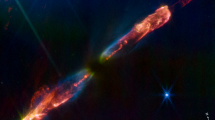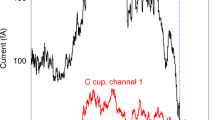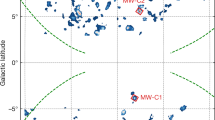Abstract
The Earth constantly loses matter, mostly in the form of H+ and O+ ions, through various outflow processes from the upper atmosphere and ionosphere. Most of these ions are cold (below 1 eV in thermal energy), but can still escape and travel farther out along the magnetic field lines into the magnetospheric tail lobes1,2. The outflow has previously been measured close to the Earth3,4,5,6,7. To understand what fraction does not return but instead escapes, the measurements should be conducted at larger geocentric distances. However, at high altitudes the cold ions are normally invisible to spacecraft measurements, because the potential of a sunlit spacecraft exceeds the equivalent energy of the ions8,9. Here we show that cold ions dominate in both flux and density in the distant magnetotail lobes, using a new measurement technique on the Cluster spacecraft10,11. The total loss of cold hydrogen ions from the planet is inferred to be of the order of 1026 s−1, which is larger than the previously observed more energetic outflow12,13. Quantification and insight of the loss processes of the Earth’s atmosphere and ionosphere are also important for understanding the evolution of atmospheres on other celestial bodies.
This is a preview of subscription content, access via your institution
Access options
Subscribe to this journal
Receive 12 print issues and online access
$259.00 per year
only $21.58 per issue
Buy this article
- Purchase on Springer Link
- Instant access to full article PDF
Prices may be subject to local taxes which are calculated during checkout



Similar content being viewed by others
References
Moore, T. E. & Horwitz, J. L. Stellar ablation of planetary atmospheres. Rev. Geophys. 45, RG3002 (2007).
Yau, A. W., Abe, T. & Peterson, W. K. The polar wind: Recent observations. J. Atmos. Sol.-Terr. Phys. 69, 1936–1983 (2007).
Abe, T., Yau, A. W., Watanabe, S., Yamada, M. & Sagawa, E. Long-term variation of the polar wind velocity and its implication for the ion acceleration process: Akebono/suprathermal ion mass spectrometer observations. J. Geophys. Res. 109, 9305–9317 (2004).
Cully, C. M., Donovan, E. F., Yau, A. W. & Arkos, G. G. Akebono/Suprathermal Mass Spectrometer observations of low-energy ion outflow: Dependence on magnetic activity and solar wind conditions. J. Geophys. Res. 108, 10.1029/2001JA009200 (2003).
Moore, T. E. et al. High-altitude observations of the polar wind. Science 277, 349–351 (1997).
Su, Y.-J. et al. Polar wind survey with the Thermal Ion Dynamics Experiment/Plasma Source Instrument suite aboard POLAR. J. Geophys. Res. 103, 29305–29337 (1998).
Peterson, W. K., Collin, H. L., Lennartsson, O. W. & Yau, A. W. Quiet time solar illumination effects on the fluxes and characteristic energies of ionospheric outflow. J. Geophys. Res. 111, 11–25 (2006).
Eriksson, A. I. et al. Electric field measurements on Cluster: comparing the double-probe and electron drift techniques. Ann. Geophys. 24, 275–289 (2006).
Pedersen, A. et al. Electron density estimations derived from spacecraft potential measurements on Cluster in tenuous plasma regions. J. Geophys. Res. 113, A07S33 (2008).
Engwall, E. et al. Low-energy (order 10 eV) ion flow in the magnetotail inferred from spacecraft wake observations. Geophys. Res. Lett. 33, 6110–6113 (2006).
Engwall, E. et al. Correction to Low-energy (order 10 eV) ion flow in the magnetotail inferred from spacecraft wake observations. Geophys. Res. Lett. 33, 14102 (2006).
Yau, A. W., Peterson, W. K. & Shelley, E. G. Modeling Magnetospheric Plasma 211–217 (Geophysical Monograph 44, American Geophysical Union, 1988).
Peterson, W. K., Collin, H. L., Yau, A. W. & Lennartsson, O. W. Polar/Toroidal Imaging Mass-Angle Spectrograph observations of suprathermal ion outflow during solar minimum conditions. J. Geophys. Res. 106, 6059–6066 (2001).
Yau, A. W. & André, M. Sources of ion outflow in the high latitude ionosphere. Space Sci. Rev. 80, 1–25 (1997).
Chappell, C. R. et al. The adequacy of the ionospheric source in supplying magnetospheric plasmas. J. Atmos. Sol.-Terr. Phys. 62, 421–436 (2000).
Huddleston, M. M. et al. An examination of the process and magnitude of ionospheric plasma supply to the magnetosphere. J. Geophys. Res. 110, 12202–12230 (2005).
Cully, C. M., Donovan, E. F., Yau, A. W. & Opgenoorth, H. J. Supply of thermal ionospheric ions to the central plasma sheet. J. Geophys. Res. 108, 1092–1099 (2003).
Mukai, T. et al. Geotail observation of cold ion streams in the medium distance magnetotail lobe in the course of a substorm. Geophys. Res. Lett. 21, 1023–1026 (1994).
Hirahara, M. et al. Cold dense ion flows with multiple components observed in the distant tail lobe by Geotail. J. Geophys. Res. 101, 7769–7784 (1996).
Sauvaud, J.-A. et al. Case studies of the dynamics of ionospheric ions in the Earth’s magnetotail. J. Geophys. Res. 109, 10.1029/2003JA009996 (2004).
Liemohn, M. W. et al. Occurrence statistics of cold, streaming ions in the near-Earth magnetotail: Survey of Polar-TIDE observations. J. Geophys. Res. 110, 7211–7226 (2005).
Olsen, R. C. The hidden ion population of the magnetosphere. J. Geophys. Res. 87, 3481–3488 (1982).
Seki, K. et al. Cold ions in the hot plasma sheet of Earth’s magnetotail. Nature 422, 589–591 (2003).
Keika, K. et al. Contribution of charge exchange loss to the storm time ring current decay: IMAGE/HENA observations. J. Geophys. Res. 111, A11S12 (2006).
Lindsay, B. G. & Stebbings, R. F. Charge transfer cross sections for energetic neutral atom data analysis. J. Geophys. Res. 110, 12213–12222 (2005).
Dubinin, E. et al. Structure and dynamics of the solar wind/ionosphere interface on Mars. MEX-ASPERA-3 and MEX-MARSIS observations. Geophys. Res. Lett. 35, L11103 (2008).
Gustafsson, G. et al. The Electric Field and Wave Experiment for the Cluster Mission. Space Sci. Rev. 79, 137–156 (1997).
Paschmann, G. et al. The Electron Drift Instrument for Cluster. Space Sci. Rev. 79, 233–269 (1997).
Engwall, E., Eriksson, A. I. & Forest, J. Wake formation behind positively charged spacecraft in flowing tenuous plasmas. Phys. Plasmas 13, 2904–2913 (2006).
Svenes, K. R., Lybekk, B., Pedersen, A. & Haaland, S. Cluster observations of near-earth magnetospheric lobe plasma densities—a statistical study. Ann. Geophys. 26, 2845–2852 (2008).
Nagai, T. et al. First measurements of supersonic polar wind in the polar magnetosphere. Geophys. Res. Lett. 11, 669–672 (1984).
Acknowledgements
Magnetic field data from the Cluster FGM instrument (principal investigator E. Lucek) has been used in the analysis.
Author information
Authors and Affiliations
Contributions
E.E. analysed the data, contributed to method development and had the main responsibility for writing the paper, A.I.E. developed the method and contributed to analysing the data and writing the paper, C.C. contributed to analysing the data and writing the paper, M.A. had the main responsibility for the EFW instrument and contributed to writing the paper, R.T. had the main responsibility for the EDI instrument and R.T. and H.V. provided EDI data and comments on the EDI instrument operation.
Corresponding author
Rights and permissions
About this article
Cite this article
Engwall, E., Eriksson, A., Cully, C. et al. Earth’s ionospheric outflow dominated by hidden cold plasma. Nature Geosci 2, 24–27 (2009). https://doi.org/10.1038/ngeo387
Received:
Accepted:
Published:
Issue Date:
DOI: https://doi.org/10.1038/ngeo387
This article is cited by
-
The variable source of the plasma sheet during a geomagnetic storm
Nature Communications (2023)
-
What are the fundamental modes of energy transfer and partitioning in the coupled Magnetosphere-Ionosphere system?
Experimental Astronomy (2022)
-
Future Missions Related to the Determination of the Elemental and Isotopic Composition of Earth, Moon and the Terrestrial Planets
Space Science Reviews (2020)
-
Magnetospheric Studies: A Requirement for Addressing Interdisciplinary Mysteries in the Ice Giant Systems
Space Science Reviews (2020)
-
The Role of the Ionosphere in Providing Plasma to the Terrestrial Magnetosphere—An Historical Overview
Space Science Reviews (2015)



